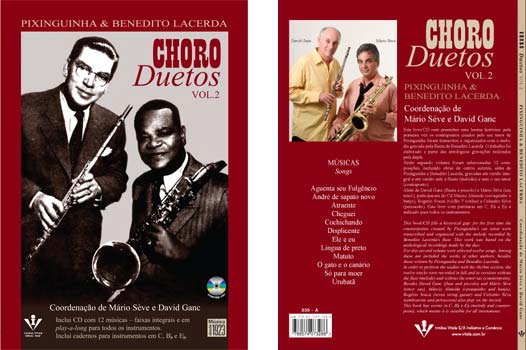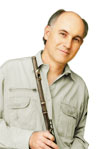Choro Duetos – Pixinguinha e Benedito Lacerda, Vol. 2
Coordenação de Mário Sève e David Ganc

This book/CD fills a historical gap: for the first time the counterpoints created by Pixinguinha’s sax tenor were transcribed and organized with the melody recorded by Benedito Lacerda’s flute. This work was based on the anthological recordings made by the duo.
For this second volume were selected twelve songs. Among these are included the works of other authors, besides those written by Pixinguinha and Benedito Lacerda.
In order to perform the studies with the rhythm section, the twelve tracks were recorded in full and in versions without the flute (melody) and without the tenor sax (counterpoint).
Besides David Ganc (flute and piccolo) and Mário Sève (tenor sax), Márcio Almeida (cavaquinho and banjo), Rogério Souza (seven string guitar) and Celsinho Silva (tambourine and percussion) also play on the record.
This book has scores in C, Bb e Eb (melody and counterpoint), which means it is suitable for all instruments.
Downloads:
- Sample – PDFs Cochichando C – melody and Cochichando Bb – counterpoint and mp3 full version and play-a-long version
- Release Photo (150DPI)
- Press release (in portuguese)
Authors’ noteChoro duets – Pixinguinha e Benedito Lacerda fills a historical gap: for the first time the counterpoints created by Pixinguinha’s tenor sax were transcribed and organized along with the melodies recorded by Benedito Lacerda’s flute to be studied and practiced in various instrumental formations. The audition of the anthological recordings made by the duo in the 1940s was the basis for this work.For this second volume we selected 12 songs recorded on disc or simply performed by the duo on radio bradcasts. Among these are included the works of other authors, besides those written by Pixinguinha e Benedito Lacerda.
SongbookAll songs are arranged with the melody on the left page and the counterpoint on the right-hand page so that two performers will be able to read together the two voices.To begin with we wrote the flute (in C, to be played one octave higher) and the tenor sax (in Bb, sounding an octave below, naturally) scores; so they become the reference for all the transpositions made.They were also ordered in three versions, each with 12 songs and their melodies and counterpoints.
The first version (in the body of the book) is in C, for non-transposing instruments, with the melody in the treble clef and the counterpoint in the bass clef.
The two other versions attached, in Bb and in Eb, are for the transposing instruments.
In the scores in Eb and the counterpoint in C we made some adaptations in the octaves, or a few changes of notes related to the original melodies, due to the different ranges of the instruments to be used with this book.
This work can be enjoyed by a wide range of musical instruments. Besides the flute, the mandolin, the violin, the piano, the accordion and the oboe (C instruments that read the treble clef), the cello, the piano, the bass, the tuba, the bassoon (in C in the bass clef), the tenor sax, the soprano sax, the clarinet, the bass clarinet, the trumpet (in Bb), the alto sax and the baritone sax (Eb) can also be used.
Thus, the songs can be played with the following suggested duos: flute and tenor sax, soprano sax and tenor sax, violin and cello, trumpet and trombone, mandolin and guitar, clarinet and bass clarinet, oboe and bassoon, accordion and baritone sax; piano and bass; and there are several other possible combinations, as melody and counterpoint are available for all instruments. It should always be remembered that the original duo is the one that joins the flute (an octave higher) and the tenor sax, and they sound two octaves distant. Therefore, where possible, other formations must respect this relationship.
It’s also important to remark that, as it’s usual in the language of choro, the performers play each repetition differently, ornamenting and embellishing the melodic phrases. In his live performances, Pixinguinha always improvised new counterpoints, displaying all his genius.
On the duo’s recordings some counterpoints were consolidated. In this book’s selected songs the best versions of each part were chosen (A, B and C), sometimes merging phrases played on several repetitions.
Play-a-long CDThe CD that comes with this book can be enjoyed simply through its audition or by practicing along. The first 12 songs can be heard as a normal audio CD. The remaining are the rhythm section without the flute and the tenor sax.On tracks 1 to 12, the songs were recorded in full, with melodies and counterpoints performed by the authors David Ganc (flute) and Mário Sève (tenor sax), joined by Rogério Souza (guitar), Márcio Almeida (cavaquinho and banjo) and Celsinho Silva (percussion).The melody (flute) and the counterpoint (tenor sax) were interpreted as follows: the first time each part was performed (A, B and C) the performances were faithful to the score. On the replays a freer form was used, as it usually happens in choro.
Also note that if you place your sound system’s pan to the right side, you’ll hear the flute and the rhythm section without the sax, and you’ll be able to practice the counterpoint. If you do the reverse, you’ll hear the sax and the rhythm section without the flute, and you’ll be able to practice the melody.
On track 13 the note A (440 Hz) is recorded four times, for you to tune your instrument.
On tracks 14 to 27, the same songs from tracks 1 to 12 appear only the rhythm section. So, you’ll be able to practice individually or in a duo, performing the melody or the counterpoint. Note that before each song, you can hear the count of two bars and then three beats (when you have a pick up) or four beats (no pick up).
Tracks 26 e 27, respectively, “Aguenta Seu Fulgêncio” and “O Gato e o Canário” – included as bônus tracks – were recorded with slower tempo, for study purposes.
The songs “André de Sapato Novo” (tracks 2 and 15) and “Atraente” (tracks 3 and 16), ossi bars, indicate the way fermatas, caesuras and rittardandos were executed.
After playing the melodies and the counterpoints of the book, feel welcome to practice your improvisations and create your own melodic lines. For this, the harmony is written in all scores. In bars without chords the previous bar’s chord must be repeated.
Please note that the transpositions (C, Bb or Eb), the numbers of the corresponding CD tracks (the complete arrangements and the play-a-long) and the tempo (a quarter note =) can be seen in the the upper left corner of each sheet.
Just like us, you’ll be amazed to discover Pixinguinha’s and Benedito Lacerda’s musical thinking, enjoy their music, their arrangements and all the possibilities of this book /CD.
David Ganc e Mário Sève






